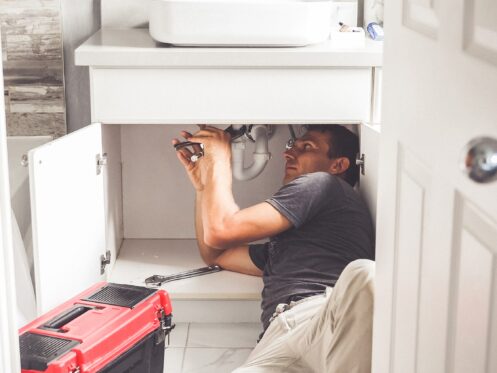While do-it-yourself (DIY) trends are increasingly popular for many household tasks, it’s crucial to understand the risks associated with DIY plumbing repairs. There is an allure of saving money and a sense of accomplishment in carrying out repairs yourself. Seemingly minor missteps can lead to devastating, costly damage, and potential health risks. Discover DIY plumbing projects that homeowners commonly undertake, what could go wrong with each, and why leaving plumbing repairs to a professional plumber is always beneficial.
Fixing a Leaky Faucet
A leaky faucet might signal a worn-out washer, a deteriorated valve seat, or a corroded fixture. Each component ensures water only comes out when you want it to. Incorrect faucet assembly after a DIY repair could lead to misaligned components, causing more leaks and potential water damage. Moreover, identifying the right washer size or the real cause of the leak can be challenging for an untrained eye. Professional plumbers bring the right diagnostic tools and comprehensive knowledge of various faucet types, ensuring effective repairs and preventing future issues.
Repairing a Running Toilet
A running toilet is not only annoying but wasteful. It can occur due to a faulty flapper, fill valve, or overflow tube. When DIYing, it’s easy to install an incompatible part or incorrectly position the new component, leading to an inefficiently functioning toilet or even worsening leaks. Plumbers have extensive knowledge about various toilet models, ensuring the correct parts are used and professionally installed to prevent future leaks or inefficient water use.
Replacing a Shower Head
Replacing a shower head may be necessitated by reasons such as an old or faulty shower head or simply the desire for an upgrade. While seemingly simple, DIY efforts can go awry quickly. An overly forceful removal can damage the threads on the shower arm, potentially causing leaks within the wall. Inadequate sealing during the installation of a new showerhead can also result in persistent leaks, contributing to further structural damage.
Professional plumbers have the expertise to gauge the appropriate force required to remove the shower head, mitigating the risk of thread or structural damage. They also know how to choose the correct sealant and apply it effectively to ensure a watertight connection between the new shower head and shower arm. This professional approach ensures the proper installation of the shower head, preventing potential issues and guaranteeing the fixture’s longevity.
Installing a New Faucet
Faucet installation is not just about fitting the new piece aesthetically; it must be sealed correctly. Misalignment or faulty seals can lead to serious water leaks, leading to potential property damage. You’ll need someone who understands the nuances of various faucet types to ensure leak-free installations and long-term peace of mind.
Fixing a Leaky Pipe
Leaks are typically symptomatic of more serious concerns, including pipe corrosion, poor connections, or excessive water pressure. Left unresolved, these issues can evolve into more significant complications, escalating the repair costs and causing substantial property damage.
DIY attempts to address a leaky pipe often involve temporary solutions like applying epoxy putty or using repair clamps. While these methods may temporarily stop the leak, they do not address the root cause of the problem. A patch repair may hold for a while, but it places additional pressure on the rest of the pipe, potentially leading to new leaks or even a catastrophic pipe burst.
Plumbers take a comprehensive approach to pipe leaks. They locate and repair the leak, as well as conduct a thorough diagnosis to identify and address the underlying issue, whether it be corrosion, a poorly soldered joint, or excessive water pressure. Moreover, professional plumbers can replace sections of pipe or the entire pipe as required, ensuring a long-lasting solution rather than a temporary fix.
Replacing an Old Water Heater Element
Over time, the heating elements of your water heater may burn out, leaving you with lukewarm or cold water. Sediment build-up from hard water can also coat the element, causing it to overheat and eventually fail. Several things can go wrong in a DIY replacement of a water heater element. Firstly, electric water heaters pose a risk of electric shock if not properly turned off and disconnected during replacement. Furthermore, incorrect installation of the heating element can lead to inefficient heating.
A plumber is well-versed in the proper procedures, from safely disconnecting the power to precisely installing the new element. The plumber can also assess the condition of other water heater components, ensuring everything is in good working order.
Fixing a Slow Shower Drain
A slow shower drain can be caused by accumulated hair, soap scum, and debris that clogs up the drain over time. Using a plunger forcefully may damage the drain line. Moreover, aggressive use of a drain snake can scratch the pipe interior, opening the door to future problems such as rust. The over-reliance on chemical drain cleaners can also weaken the pipes and eventually cause them to leak or rupture.
A professional plumber uses advanced techniques, such as hydro jetting, to safely and effectively clear the clog without damaging the pipes. The plumber can also employ video inspection equipment to directly view the extent and location of the blockage, ensuring a targeted and effective resolution.
Adjusting Water Pressure
Your home’s water pressure can be affected by issues such as clogged aerators in your faucets, partially closed shut-off valves, or malfunctioning pressure-reducing valves (PRVs). Attempting to adjust the pressure yourself without correcting the underlying issue can create more problems than it solves. If the water pressure is set too high, it can put undue stress on your pipes and fixtures, leading to leaks or even burst pipes. On the other hand, setting the pressure too low can result in inadequate water flow, causing issues like clogged drains and poor shower performance.
A professional plumber will first diagnose the issue accurately. This process may involve checking the water pressure at various points, inspecting the PRVs, and examining the overall state of the plumbing system. Once the cause is identified, the plumber can make the necessary adjustments. This can include cleaning or replacing clogged aerators, opening shut-off valves, or adjusting, repairing, or replacing the PRV.
Fixing a Jammed Garbage Disposal
Garbage disposals are powerful appliances that can be dangerous if not handled correctly. Attempting to fix a jam can lead to personal injury or further damage to the disposal unit. A professional plumber can safely troubleshoot, repair, or replace the unit using specialized tools and protective measures, ensuring safe and effective operation.
Replacing a Broken Toilet Handle
The toilet handle is a small but essential part of your toilet. If it breaks or malfunctions, it can prevent effective flushing. The DIY replacement process may seem easy, but an incorrect handle or poor installation can lead to a non-functioning or loose handle. A plumber can ensure a correct fit and smooth operation, saving you the trouble of a do-over.
Contact a Professional Plumber Near You Today
Don’t let plumbing issues inconvenience you or cause unnecessary damage to your home or business. Instead, entrust your plumbing needs to a local professional around Anaheim, CA who can ensure safety and is available 24/7 for emergencies. Contact Splash Plumbing today for reliable plumbing services, from backflow testing to water treatment and high-pressure jetting.












